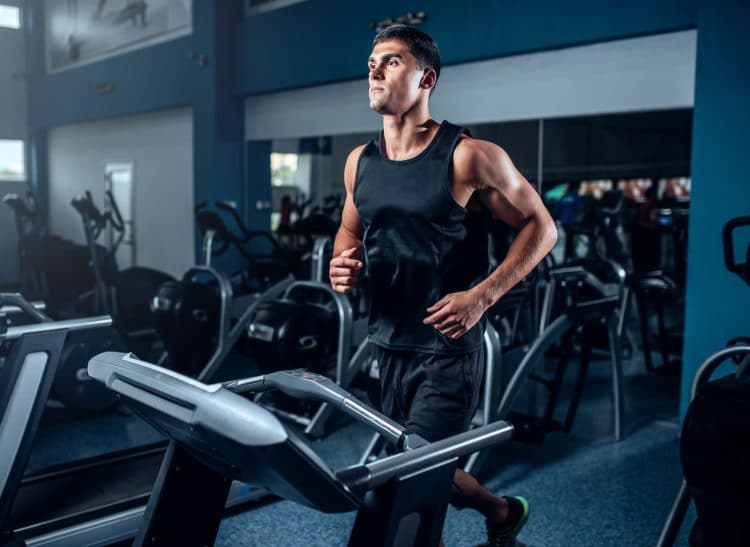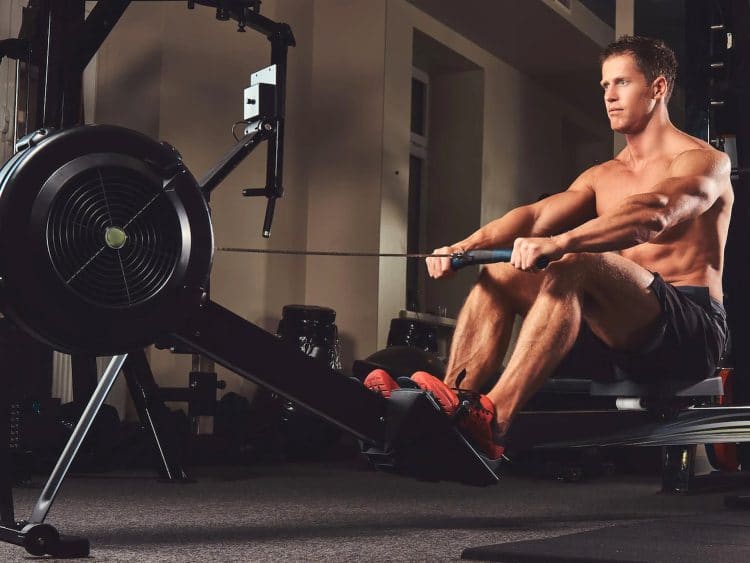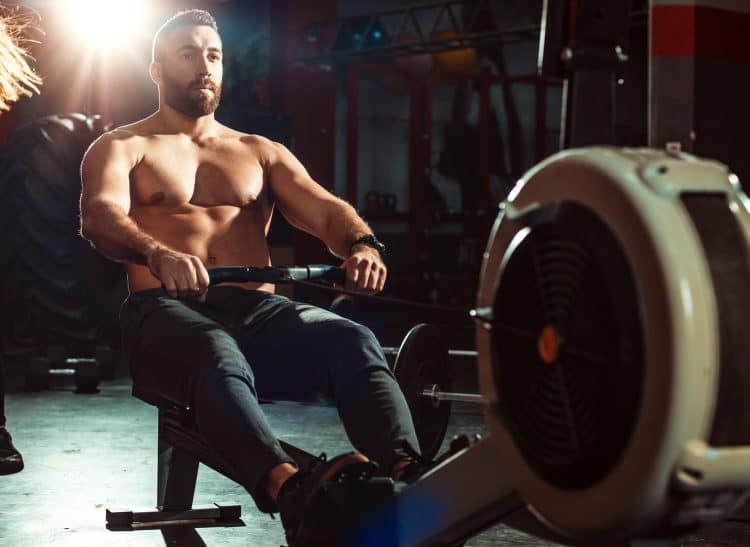Whether you have joined a gym to lose weight or put on muscle mass, you probably would be doing some form of cardio in your workouts. Choosing a cardio machine is not as easy as it might sound. Gone are the days when running around your block was your only cardio option.
In the age of fancy gyms, you are surrounded by a range of equipment begging for you to use them as soon as you walk into the cardio section. With all said and done, treadmills and rowing machines are probably the most popular cardio equipment.
If you think about it, golden days were golden probably because workouts were pretty straightforward back then. You had to make do with a handful of equipment. Did limited workout machines make the workouts monotonous? Sure.
But on the bright side, you did not waste time deciding which equipment was better than the other.
Rowing Machine vs Treadmill – Overview
If you are at a crossroads and are having a hard time deciding between the two machines, there are a few things you need to consider before making the final decision. In this review, we will go over:
- Use cases
- How to perform each exercise
- Muscles involved
- Advantages and disadvantages
- Muscle building ability
- Calorie burning ability
- Impact on joints
- Final verdict
1. Use Cases: Rowing Machine vs Treadmill
The demand for cardio equipment has shot up significantly, especially in the last couple of years, owing to the novel coronavirus. Many people who went to the gym to lose weight and spent most of their time on cardio equipment now prefer working out in the comfort and security of their homes.
Level Up Your Fitness: Join our 💪 strong community in Fitness Volt Newsletter. Get daily inspiration, expert-backed workouts, nutrition tips, the latest in strength sports, and the support you need to reach your goals. Subscribe for free!
The thing is, cardio equipment have improved by leap and bounds over the last few years. From manual treadmills of the 90s to the smart screen-enabled rowing machines and treadmills of today, cardio machines have come a long way.
Many individuals hated the idea of spending 15-20 minutes on a cardio machine because it was the dullest part of their day. But now that you can watch your favorite Netflix shows while rowing, people tend to outstay their welcome.
Things you need to consider while buying a rowing machine or treadmill for home use:
1. Space
Unless you are a gazillionaire, you probably have limited space at home for a cardio machine. Most rowing machines have an approximate footprint of 8′ X 2′, meaning it does not take up much space.
On the other hand, a treadmill can be the elephant in the room. Even when folded, treadmills can take up significant space. It can be a problem if you do not have a dedicated gym room at your home.
2. Cost
We agree that cardio machines with a 13-inch screen can burn a hole in your pocket, but there are two other things you need to know; firstly, those extra dollars are worth it. Secondly, the cost of a cardio machine goes beyond their ticket price.
The up-front and ongoing (maintenance) costs of a treadmill are significantly higher than a rowing machine. Treadmills are motorized, have belts, shock absorbers, and a more complex computer. They are generally used at high speeds and high intensities.
A rower is a much simpler machine. There is no motor, just a chain, and a flywheel, and the moving parts are limited to a chain, fan, and seat. On top of this, unlike the treadmill, the rower does not add to your electricity bill.
Related: Running Calorie Calculator: Calories Burned Running Calculator
2. How To Perform: Treadmill vs Rowing Machine
While using a treadmill is relatively simple, getting used to a rower can take some time. To make most of both the machines and reduce the chances of an injury, you need to follow the correct form while performing each exercise.
Treadmill Running Tips
Running on a treadmill is a little different from jogging around your block or in a park. Here are a few things you need to consider while using a treadmill:
- Keep your toes pointing forward: The natural tendency of turning your feet out slightly can strain your knees. If it feels hard, cut back your speed and incline and run at a slow to moderate speed while you get your feet in line.
- Always run tall: To do this effectively, you need to engage your glutes. Doing this will help keep your pelvis upright and your hip bones facing forward. When runners get tired, they usually let their hips drop back to disengage the glutes. Letting your hips drop can put unnecessary tension on your lower back.
- Focus on your arm swing: The correct arm swing can help you generate power. To do this, do not let your arms cross the midline of your body. A linear front-to-back arm swing can help generate more power and reduce strain on your chest, abdominal, and lower back.
Related: Running Calculator: Running Pace Calculator
Rowing Machine Tips
Using a rower has a learning curve to it. There are four stages of proper rowing:
- The Catch: Start with a proper set-up at the front of the machine. Your shins should be vertical, lats engaged, shoulders relaxed, and core braced. Your torso should be leaning forward at a 1 o’clock position with shoulders in front of hips.
- The Drive: While maintaining a forward torso tilt, apply force through your legs to the machine to extend your legs. In a fluid continuous movement, continue to push through your legs and start to hinge backward at the hip.
- The Finish: Once your legs are fully extended and your torso is at an 11 o’clock position, use your arms to pull the handle to the bottom of your chest.
- The Recovery: Reverse the motion by relaxing your arms away from your torso, hinge forward at the hips toward 1 o’clock, and then bend your legs back to the catch.
Must Read: 5 Rowing Mistakes You’re Probably Making
3. Muscles Involved
The treadmill primarily works your quads, hams, calves, and glutes. If you turn up the speed, you could also experience abdominal muscle activation.
Although there is upper body involvement too, it involves a slight strain on the back, shoulders, pectorals, and arm muscles. You could carry weights while running on the treadmill for better upper-body recruitment, but it can have a negative effect on your joints.
A rowing machine mimics the action of propelling a boat through the water. Unlike running on a treadmill, a rower provides a full-body workout. The sliding seat and hand-held bar ensure total body conditioning.
Every drive results in calves, quads, hamstrings, glutes, and abs recruitment. On the other hand, the finish motion results in upper body muscle engagement including obliques, pecs, biceps, triceps, deltoids, upper back, and lats. Besides, a rower can help strengthen your hands and wrists over time from gripping the bar.
Check Out: Best Running Shoes For Heavy Men Reviewed for 2024
Level Up Your Fitness: Join our 💪 strong community in Fitness Volt Newsletter. Get daily inspiration, expert-backed workouts, nutrition tips, the latest in strength sports, and the support you need to reach your goals. Subscribe for free!
4. Advantages and Disadvantages: Rowing Machine vs Treadmill
Each exercise has unique advantages and drawbacks. To make a final decision, you need to know where each exercise excels and falls behind.
1. Advantages & Disadvantages of Treadmill
Benefits of Treadmill
The advantages of using a treadmill include:
- Strengthens Your Bones: According to research, being on your feet and working against gravity can help develop more bone density.
- It’s Good for Your Heart: Running is one of the best ways of conditioning your cardiovascular system. It helps build your endurance and stamina. It is an aerobic activity that utilizes both fatty acids and carbohydrates for energy.
- Improves Your Core Strength: While a rowing workout might give your abdomen a workout, running requires engaging your core the entire time. On top of that, engaging your core for longer periods can help improve your posture.
- An Effective Lower Body Workout: Running is essentially a lower body workout as it primarily targets the quads, hamstrings, glutes, hip flexors, and calves. Running on a treadmill is an effective way of building lower body strength, stamina, and endurance.
Drawbacks of Treadmill
Since the treadmill is a high-impact exercise, it can put a lot of strain on your joints. Using sub-standard equipment that does not have adequate suspension can also strain your joints and muscles.
Next Read: The 14 Best Rowing Workouts for Fitness and Fat Burning
2. Advantages & Disadvantages of Rowing Machine
Benefits of Rowing Machine
The benefits of rowing include:
- Rowing is Low-Impact: Rowing is lower impact than running. If you are experiencing joint pain, you would be better off spending your time on a rower. It is also a great option for people recovering from a lower-body injury.
- A Full-Body Workout: While both running and rowing work your lower body, rowing is an effective upper body workout as well. Rowing is a full-body exercise as it engages your legs, arms, shoulders, and back.
- Strengthens the Core More than Running: Although running and rowing both utilize your core, rowing requires more core strength than running. The finish of each rowing stroke works similarly to a sit-up, making your core the primary muscle group of the exercise.
- Good for Your Back: Rowing is a great exercise for people who spend most of their days hunched over a computer. The correct rowing posture involves pushing your shoulder back, undoing some of the damage of hunching them forward all day.
- Strengthens Your Lower Body: Rowing is primarily leg-driven. You are essentially squatting with every rep. It is one of the benefits rowing and running have in common.
- Improves Your Cardiovascular Health: Since it is a cardio-based exercise, it helps improve your stamina and strength.
Drawbacks of Rowing Machine
Rowing is an indoor activity unless you are resourceful like the Winklevoss twins. If done with an incorrect form, rowing can put unnecessary strain on your lower back.
Check Out: Treadmill Calorie Calculator
5. Muscle Building: Rowing Machine vs Treadmill
Both rowing machines and treadmills have muscle-building potential, but let’s dive deeper to analyze which of the two is better if building muscle mass is your primary focus.
A treadmill primarily targets your lower body. Also, you do not have a lot of options for increasing resistance on a treadmill to put additional tension on your muscles. You could crank up the speed or increase the incline, but that only increases the strain on your lower back.
However, rowing machines are great for building muscle mass. A rower works your upper and lower body, and you could increase the resistance by cranking up the damper.
If you could only have one machine at your home, a rowing machine would be a better choice as you could get creative with it. You could perform a variety of biceps, traps, back, legs, and triceps exercises using the rower.
6. Calorie Burning: Rowing Machine vs Treadmill
More than building muscle, calorie burning is a far more common reason why people work out. It is also the reason why your gym’s cardio section is more crowded as compared to the weight room.
It is no secret that running is one of the most effective ways of burning calories. Only a few other exercises can match the energy-expending potential of the treadmill.
While a rowing machine can provide you with a full-body workout, it cannot match a treadmill’s intensity potential to burn maximal calories.
Assuming you are working out at the same intensity on both machines, a treadmill is likely to better activate your cardiovascular system and help burn higher calories.
7. Impact on Joints: Rowing Machine vs Treadmill
Impact on joints can make all the difference in choosing between a rowing machine and a treadmill. The impact of an exercise is the strain on your joints that comes from movement and gravity.
High-impact exercises can lead to pain and injuries. Low impact exercises, on the other hand, can be just as effective and are a much better choice for beginners and people dealing with injuries.
Although the treadmill is an excellent calorie-burning machine, it has some drawbacks. Running is a high-impact exercise. According to research, 19-79% of runners will develop an injury of some sort through the sport.
A rowing machine, on the other hand, is a low-impact exercise. Since you are sitting throughout the exercise, you do not have to work against gravity. A rowing machine activates more muscles than you would on a treadmill but still has a negligible impact on your joints.
Check Out:
- Our 10 Best Indoor Rowing Machine Picks for 2024
- 7 Best Treadmills Reviewed In 2024
- Curved Treadmills: Everything You Need to Know
8. Final Verdict
Treadmill and rowing machines are great cardio equipment to improve your cardiovascular strength and help burn calories. Your final choice will depend on your ultimate fitness goal.
If weight loss is your primary goal, a treadmill will be the perfect fit for you. However, if you want to build muscle, improve conditioning, and burn fat, a rowing machine should be your preferred training equipment.












